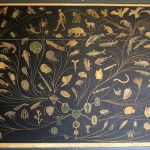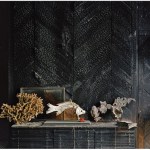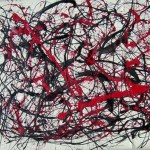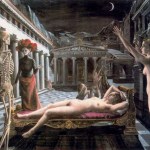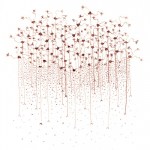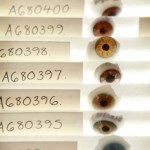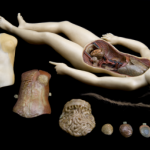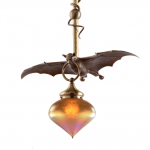Museum Lust
This beautiful painting is located in Martin Hall at Swarthmore College. Discovered via Colin Purrington's flickr feed.
This Tuesday, April 7, the Koshland Science museum in DC is hosting a book talk:
Join NASA scientist Gavin Schmidt and accomplished photographer Joshua Wolfe as they demonstrate how photographs can illustrate the effects of global warming more poignantly than any temperature graph or chart. The two will show photos and satellite images of retreating glaciers, sinking villages in Alaska's tundra, and drying lakes from their new book, Climate Change: Picturing the Science. They will also discuss how scientists gather climate data and come up with cutting-edge research findings.
RSVPs are…
Norwich State Hospital, Piano
"New England Ruins"
Rob Dobi, 2005
Three quietly stunning collections of photos mix the ache of loss with the unintentional but undeniable beauty of decay. First, Rob Dobi's "New England Ruins" documents abandoned buildings in various states of abandonment. His compositions vary from grand (abandoned stages and performance halls) to mundane (a chair fallen down a flight of stairs, the back of a derelict television). Norwich State Hospital, Piano (above) captures a broken piano, its innards undulating like the skeleton of a grilled trout, under a crude mosaic of…
It's Ada Lovelace Day!
Ada Lovelace (1815 - 1852) is often referred to as the world's first computer programmer. The daughter of the famous poet Lord Byron, and the admired intellect, Annabella Milbanke, Ada Lovelace represented the meeting of two alternative worlds: the romanticism and art of her father versus the rationality and science of her mother. In her attempt to draw together these polar opposites and create a 'poetical science' during the Victorian age, Ada collaborated with the renowned mathematician and inventor, Charles Babbage. (source)
I'm betting famous names like Marie Curie…
The Sleeping Venus (1944)
Paul Delvaux
Observatory is a new collaborative art space located in Brooklyn, where it is reportedly sandwiched between Proteus Gowanus, Cabinet Magazine, and the Morbid Anatomy library. Its illustrious proprietors include Pam of Phantasmaphile, Joanna of Morbid Anatomy, and D&M of Curious Expeditions. And if that's not reason enough to be excited, tonight they are hosting a talk by Kathryn Hoffmann of the University of Hawaii at Manoa, entitled "Reveries of Sleeping Beauty: Slumber and Death in Anatomical Museums, Fairground Shows, and Art."
I saw Dr. Hoffmann…
Thought Patterns #1
blood on watercolor paper
Laura Splan, 2003
The International Museum of Surgical Science in Chicago is calling for proposals for "Anatomy in the Gallery:"
[This program] showcases medically themed contemporary art within the unique context of the Museum's historical collections and exhibits. The program was begun in 1998 to help fulfill the Museum's mission of enriching its visitors' lives by enhancing their knowledge and understanding of surgery and related sciences.
Previous exhibitors include Laura Splan (above), Laura Kurtenbach, Geraldine Ondrizek, and Dominic Paul…
A drawer of antique glass eye fragments
Photograph: Peter Macdiarmid/Getty Images
via The Guardian
A new slideshow from The Guardian highlights some of the wonderful medical artifacts found at the new "Brought to Life" website.
Wax anatomical figure of reclining woman, Florence, Italy, 1771-1800
Science Museum London
Starting today, the Wellcome Trust and sciencemuseum.org.uk open a brand spanking new collection of medical history archives. "Brought to Life: Exploring the History of Medicine" is searchable by people, place, thing, theme, and time. You can view a timeline of medical history in Europe next to similar timelines for the Islamic empire, Egypt and Greece (I do wish China and India were as prominently placed). You can read essays about larger questions, like what "wellness" means, or play with a cool…
Yup, that's a flying bat gripping a lamp in its mouth, with his buddy, a coiled snake, crawling along above him. And it's not a faux-Victorian, nouveau-Goth creation - it's a replica of an actual late 1800s fixture, by eclectic lighting company Rejuvenation. Seriously - over a hundred years ago, someone thought this was the greatest lamp evah! I'm not sure I'd actually choose the Dracula-esque Drake fixture for myself, mind you; not only is it more than $2K, I think you need a very special space for this 45" long creation. Like a living room designed by Edward Gorey. But if you've got that…
My friend Nicole sent me this WSJ article about a month ago - it's about the sad reality that artworks made with nonarchival materials often don't outlive the artist:
Art is sold "as is" by galleries or directly from artists. (Can you imagine Consumer Reports reviewing art?) Still, dealers hope to maintain the goodwill of their customers, and artists don't want to develop a reputation for shoddy work. But it's not fully clear what responsibility artists bear to their completed work, especially after it has been sold. That's particularly the case for artists who purposefully use ephemeral…
Leonotis nepetaefolia and Doctor Humming Birds, Jamiaca
Marianne North (1830-1890)
Kew Royal Botanic Gardens
Sponsorship price: £1,000
832 paintings in the Marianne North Gallery at Britain's Kew Botanic Gardens are up for adoption. No, you don't get to name them or take them home - but you do get a print and other benefits.
All of these paintings are the work of Marianne North, a prolific and Victorian artist who traveled throughout the British empire documenting native flora and fauna in her own idiosyncratic style. Independently wealthy, North gave the gallery building and the…
Ready for the weekend? Having trouble focusing? Indulge yourself in this luscious nine-minute film from the National Gallery of Art about Vermeer's masterpiece "The Music Lesson." It leisurely unpacks the painting's geometry and shadows, showing a glimpse of the techniques that let Vermeer make quotidian Delft resemble a gold-drenched daydream.
Vermeers are often described as highly realistic, crisp, even jewel-like. Although the illusion of reality is powerful, Vermeer, like all good artists, made judicious alterations to the scene before him. This video of "The Music Lesson" shows an…
The Pigeon of Passage
The Natural History of Carolina, Florida and the Bahama Islands, 1754
Mark Catesby
Unlike Benjamin Button, he's not up for an Oscar, but he's also a film star - several hundred years late. Mark Catesby (1683-1749), a forerunner of Audubon, was the first European scientist/artist to document the flora and fauna of North America. He depicted live specimens in their natural habitats, and made special study of both migration and extinction. You can view Catesby's masterwork, The Natural History of Carolina, Florida and the Bahama Islands, Vol 1 and Vol 2, at the University…
Multiverse
Leo Villareal
National Gallery of Art
Visitors familiar with the National Gallery of Art know that its East and West wings are connected by a subterranean passageway (and a cafe with yummy gelato, and a cool waterfall, but I digress). The moving walkways in that passage are now surrounded by a twinkling LED installation by artist Leo Villareal. When you stand or walk in the tunnel, more than 40,000 LEDs sparkle in synchronized and random patterns all around you.
Villareal says the patterns in his art are inspired by nature:
I'm very interested in rules and underlying structures,…
These charming photos by bre pettis capture a lovely, detailed diorama at the Natural History Museum in Vienna. I'm not sure how old it is, but it's very cool.
You know those packaged toolchest gift sets that stores relentlessly market as holiday gifts for "Dads"? Well, none of them can hold a, er, socket wrench to this object of beauty from the 1800s, customized by a piano tuner named Studley. Wow.
Via Boing Boing
Smithsonian Castle
The US Botanic Garden is once again having its annual holiday exhibit, "Windows to Wonderland." There are two parts to this exhibit: first, there's a collection of adorable replicas of the monuments made out of bark, pinecones, leaves, gourds, etc. Second, there's a delightful room of trains running across elevated bridges and through fantasy villages with names like "Gremlin Corner" and "Caterpillar Garden."
The Capitol
The mini Capitol was pretty impressive, but it lacked its north and south wings, which went on at the same time as the current dome. So historically, it…
Ephraim Chambers
Cyclopaedia, 1728
Via Morbid Anatomy, some beautiful detail images from Ephraim Chambers' Cyclopaedia:
Cyclopaedia: or, A Universal Dictionary of Arts and Sciences (folio, 2 vols.) was an encyclopedia published by Ephraim Chambers in London in 1728, and reprinted in numerous editions in the 18th century. The Cyclopaedia was one of the first general encyclopedias to be produced in English. (source: Wikipedia
Read more at Morbid Anatomy.
Tarantula
Elizabeth Goluch
sterling silver, gold, tourmaline
Canadian artist Elizabeth Goluch's precious metal insects double as treasure-boxes. From her website:
My fascination with nature in general and with insects in particular began while I was a child growing up on a farm in southwestern Ontario. The work that I do reflects the influence of that environment -- the wildlife and the insects, as well the intricacy, the complexity and the order inherent in nature. I am drawn to the beauty, but also to the danger in nature. I relish the visible, yet can imagine much more; which gives rise…
Next week, PBA galleries in San Francisco will be auctioning rare books, prints, and ephemera from the medical library of Gerald I. Sugarman, MD. Joanna at Morbid Anatomy has distilled some of the best medical illustrations from this collection into two posts here and here. Thanks, Joanna!
This is wonderful stuff. I think Dr. Sugarman must have been an interesting character. . . the kind of guy I wish lived down the hall from me so I could borrow his books.
From "A System of Anatomy" by Samuel Collins, 1685
From "Anatomia Corporum Humanorum" by Joannem Arnoldum Langerak, 1739
